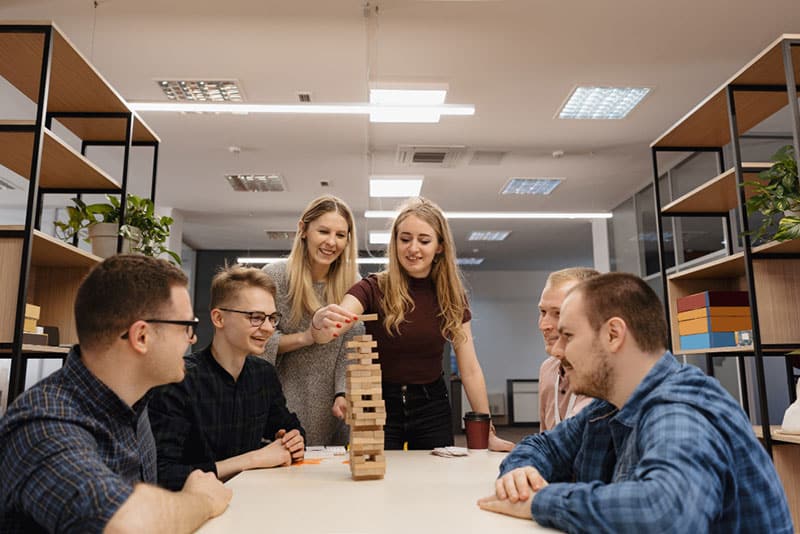Games are nothing new in the modern day and something we have enjoyed for centuries. While things started with board games, dice games, and classic child games, like hide and seek, we can experience virtual worlds and adventure on gaming consoles today. With technological advancements, we are constantly seeing new ways in which games or game elements are used in various settings. This includes more than just the use of serious games among professional players. Even in the workplace, certain game mechanics now play an essential role in enhancing employee productivity.
The main question that comes up now is whether or not there is a fundamental difference between games and gamification in the business world. This post takes a closer look at classic games and how they differ from a game framework you implement in a corporate setting.
The Basics Of A Game
While we will look at the difference between games and gamification, we should first look at game principles. This can help provide a better overview of a game and where it fits into the picture.
A game is something that is based on a few basic principles. The most important game elements that you will find include scores and trophies. Score refers to the number of coins you can collect, damage you can deal to enemies, or other elements – depending on the specific game elements used in the title. There are usually also leaderboards, which is another area where similarities are seen between gamification vs games. These leaderboards provide an overview of the people or players with the highest scores – and it helps harvest competitiveness.
Apart from these factors, a game usually allows you to earn points based on certain actions. You can sometimes spend these points to get new skills, which is directly related to your ability to improve when you play. The entire idea behind the progress bars, experience points, and other factors in these games is to add a fun, challenging effect to the player’s experience.

What Is Gamification?
When you compare gamification vs serious games, there are several differences that you will note – but the basics often remain very similar. The main difference here is that gamification generally uses certain elements at a much broader spectrum, whereas a serious game will only focus on the title itself. This is why the major difference is games focus on playing, and gamification instead addresses motivation.
The term gamification, particularly in a corporate setting, refers to using game-based elements in a work environment. There are several ways in which gamification elements can be used, and the main idea here is to boost every employee’s productivity, satisfaction, and overall efficacy. Using gamification elements can also help promote the desired behavior among employees while giving them a fun way to improve their skills and thrive in the workplace.
The Use Of Gamification In The Workplace
There are several ways in which businesses are using gamification and game-based learning to drive better performance among employees. When a business wants to incorporate this type of strategy, it is important to compare gamification and game-based learning examples. This can help the company understand how gamification can be used for the workplace in general and for gamified learning options.
There are also cases where adding game elements through an actual playable title can improve a company’s overall performance. For example, point systems can be used in a learning game to see which employees have the most potential for a specific position or project that is coming up. There have also been cases where game-based thinking was used as part of a recruitment process. In this case, the potential candidate has a risk-free setting that they can use to show a specific skill required for a particular position. The company can then look at the players’ scores, leaderboards, and progress to identify the ones with the most potential.
Game-based learning is also experiencing a significant increase in interest recently. It is estimated that internet-based learning programs will reach a global worth of around $50 billion by the year 2026. Game-based learning will often have a specific learning outcome for which the students will strive. The gamification system can award points and achievements as the employees progress through different courses. This can help to motivate the students to complete the course and obtain the skills they need to be more productive in the workplace. These apps can also make it clear to the student what learning objective they need to reach, the skills they will acquire throughout the process, and the learning outcomes. While gamification is used, new concepts can be integrated into the non-game context – such as educational videos and articles – that provide knowledge to the students.
Apart from game-based learning, it is also important to understand how gamification can be used for existing employees. Poor productivity can quickly diminish performance in a company, as the staff may not reach specific goals the business sets for itself. This could even lead to losses down the line.
With gamification, employees can access an app that tracks their overall performance in the workplace. This app will award points for completing specific tasks and may even provide extra rewards for excellent work or when tasks are completed within a specific time.
The implementation of objectives in this type of app will ensure the employees understand what they need to do to achieve certain goals.
This type of system can easily integrate a type of leaderboard system too, which can further enhance its efficacy in helping to motivate the staff members. With a leaderboard system, staff members will essentially start to compete against each other to achieve the higher rewards that are available. This means every individual will give their full 100% with every task they perform in the company, as this is where the main benefit of the gamification system comes into play.
As we have discussed, there are some areas where gamification and a game cross paths. Gamification uses the knowledge and other elements of standard games, but practices these techniques in a real-world situation. Whether in the form of gamification games or a form of teaching, there are numerous ways in which companies can effectively enhance their overall operations and performance with these strategies.
The Time is Now
Gamification is a great way to motivate employees using engagement software. There are different ways in which gamification can be used in the workplace. Still, without proper planning, the business may face a significant barrier when the plan does not increase engagement. While employees may not produce immediate feedback with gamification, this strategy can have a major positive impact over time.
Spinify provides a world-class gamification strategy that can help your company thrive. We can help you understand the difference in a comparison between gamification vs game design while also ensuring you have the knowledge to incorporate these elements in your business structure. Book a demo today and see how we can help improve your team’s performance through gamification. Want to stay updated on the news regarding gamification games in the workplace? Be sure to follow us on LinkedIn to get the latest updates that we share.



